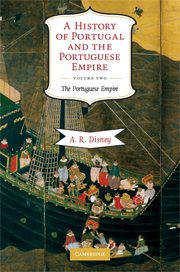Book contents
- Frontmatter
- Contents
- Abbreviations
- List of maps
- Preface
- Maps
- 15 North Africa
- 16 Exploring the Coasts of Atlantic Africa
- 17 Engaging with Atlantic Africa
- 18 The Atlantic Islands and Fisheries
- 19 Breakthrough to Maritime Asia
- 20 Empire in the East
- 21 Informal Presence in the East
- 22 Brazil: Seizing and Keeping Possession
- 23 Formation of Colonial Brazil
- 24 Late Colonial Brazil
- 25 Holding on in India: The Late Seventeenth and Eighteenth Centuries
- 26 Eastern Empire in the Late Colonial Era: Peripheries
- Glossary
- Bibliography
- Index
18 - The Atlantic Islands and Fisheries
Published online by Cambridge University Press: 05 June 2012
- Frontmatter
- Contents
- Abbreviations
- List of maps
- Preface
- Maps
- 15 North Africa
- 16 Exploring the Coasts of Atlantic Africa
- 17 Engaging with Atlantic Africa
- 18 The Atlantic Islands and Fisheries
- 19 Breakthrough to Maritime Asia
- 20 Empire in the East
- 21 Informal Presence in the East
- 22 Brazil: Seizing and Keeping Possession
- 23 Formation of Colonial Brazil
- 24 Late Colonial Brazil
- 25 Holding on in India: The Late Seventeenth and Eighteenth Centuries
- 26 Eastern Empire in the Late Colonial Era: Peripheries
- Glossary
- Bibliography
- Index
Summary
PORTUGUESE BEGINNINGS IN MADEIRA
In the eastern waters of the North Atlantic, between the latitude of Lisbon and the tropic of Cancer, lie three archipelagoes: the Madeira group, the Azores and the Canaries. The Portuguese, during the course of their Atlantic voyaging in the first half of the fifteenth century, became thoroughly familiar with all three. With crown sanction, Prince Henrique proceeded to annexe and colonise in turn first Madeira and then the Azores, beginning in the 1420s. The prince also tried to occupy various islands in the Canaries; but here he had to contend with both native resistance and strong Castilian competition – and ultimately failed.
The Madeira archipelago consists of the island of Madeira itself, Porto Santo and three small islets. It is located off the Moroccan coast about 1,000 kilometres southwest of Lisbon and within just 500 kilometres of the northern Canaries. Whether or not Madeira was known in Antiquity, and precisely when Medieval navigators became aware of it, are both uncertain. On the latter issue there is some slight but inconclusive evidence that Muslim sailors from Lisbon visited the islands sometime during the Islamic period. Be that as it may, there is no doubt that the archipelago had been discovered, or re-discovered, before 1351 because it begins to appear on Italian and Catalan maps from that date. However, the islands were uninhabited and situated a considerable distance from the mainland; so for long they attracted little attention.
- Type
- Chapter
- Information
- A History of Portugal and the Portuguese EmpireFrom Beginnings to 1807, pp. 84 - 118Publisher: Cambridge University PressPrint publication year: 2009



